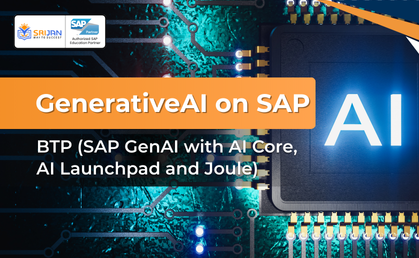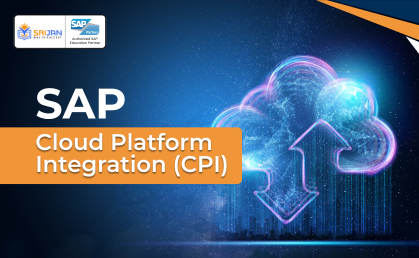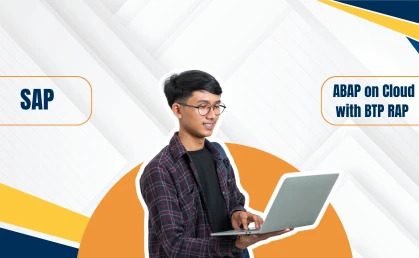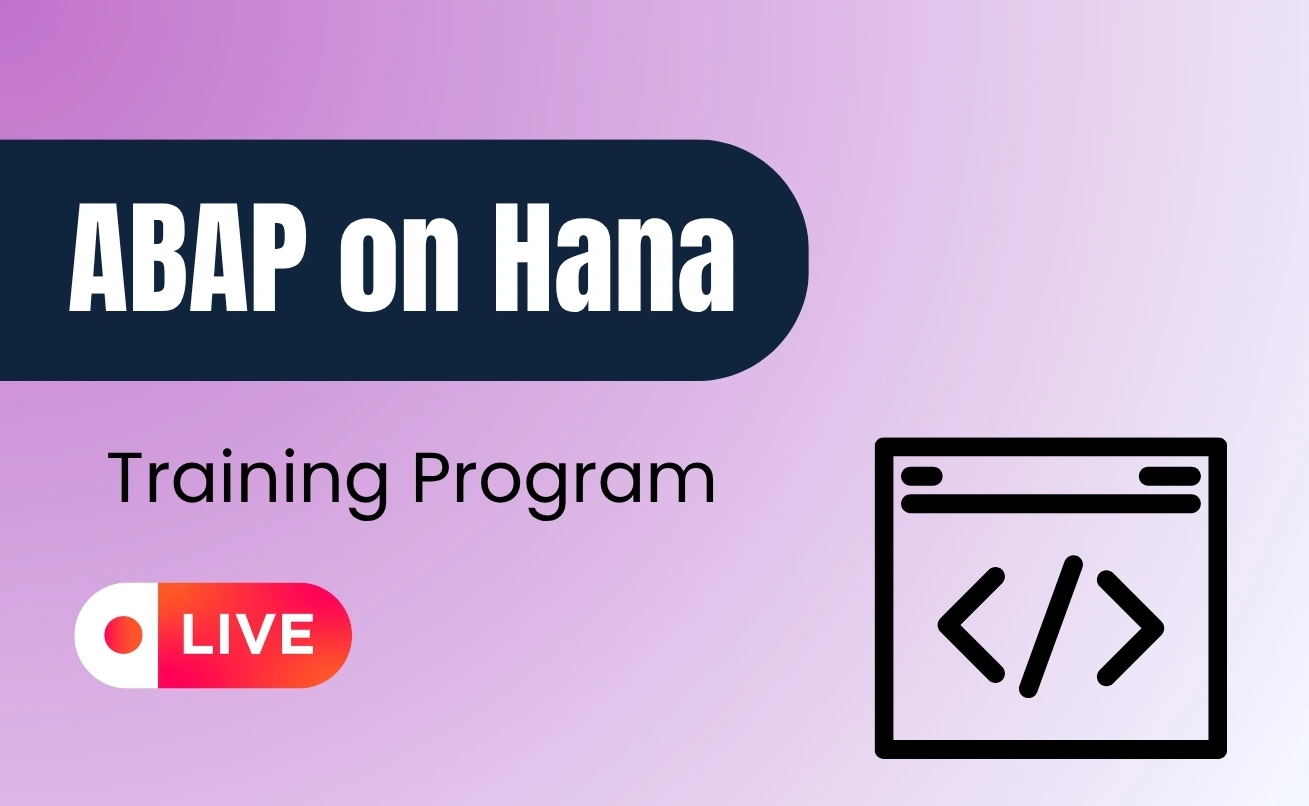If you want a strong career in SAP, learning SAP ABAP on HANA course online is a great choice. Srijan Institute offers an online sap course that is simple, practical, and perfect for freshers. You can learn everything slowly and even get certified, which will help you in being unique when applying for jobs.
This course is for students, freshers, and working experts. You will learn skills that are in high demand in IT and get confidence to work on real SAP HANA projects.
Our program also has SAP ABAP on HANA certification online, so you can show your skills and be different in the job market.
What is SAP ABAP on HANA certification about?
SAP is software used by companies all over the world to manage business activities. ABAP is SAP’s programming language, and SAP ABAP on HANA course online is the modern version made to work with SAP HANA, a very fast database.
With SAP ABAP on HANA, you can:
- Build fast applications
- Work with real-time data
- Help companies manage their business better
Even if you’ve never coded before, our online classes and tutorials make it easy to understand.
The Future of SAP ABAP in the Cloud
Many companies are moving to cloud-based software. SAP has a platform called SAP Business Technology Platform (BTP) where developers can build cloud applications. Learning ABAP on HANA helps you stay ready for these new cloud technologies.
By learning SAP ABAP on HANA course online, you’ll be prepared for the future as more businesses shift to SAP’s cloud ecosystem. You can stay updated on industry trends and build a career that is future ready, as more businesses shift to SAP’s cloud ecosystem.
Why Learn SAP ABAP on HANA course online?
Learning SAP ABAP on HANA course online is a smart step if you want a career in SAP development. SAP HANA is a fast, modern database, and ABAP is SAP’s programming language.
Here’s why many students and professionals choose our course:
- High Demand Jobs: Companies using SAP HANA need ABAP developers to build and maintain applications.
- High Salaries: Certified ABAP on HANA developers get good salaries in India and internationally.
- Future proof Skills: SAP HANA is the future of SAP technology, so learning ABAP on HANA keeps your skills new.
- Easy to Learn: If you know basic coding, you can easily learn ABAP on HANA with our engaging videos and projects.
- Career Growth: With ABAP on HANA skills, you can advance from developer to SAP consultant or admin.
Who Can Join the SAP ABAP on HANA Online Certification Course?
Our course is open to everyone who wants to start or grow a career in SAP. You don’t need to be an expert in coding because the training is structured step by step, from basics to advanced topics.
- Students and Freshers: Start your career with an in-demand SAP skill.
- Working Professionals: Upgrade your skills to work on SAP HANA projects.
- SAP Beginners: Learn SAP from scratch with easy tutorials.
- Developers and Programmers: Work on SAP HANA databases for real-time projects.
What Will You Learn in Our SAP ABAP on HANA Training Online?
Our online training explains everything from basics to advanced topics. By the end, you will be able to make real SAP HANA apps and get ready for SAP ABAP on HANA certification.
Here’s what the sap abad on hana course covers:
- Introduction to SAP HANA and ABAP: Learn the basics of SAP, ABAP, and HANA database.
- ABAP Programming topics: Learn about data types, loops, conditions, and latest programming.
- ABAP on HANA Development: make apps specifically for SAP HANA.
- SQL Script and CDS Views: Work with database scripts and Core Data Services for fast apps.
- Open SAP ABAP on HANA: Hands on new exercises for real experience.
- Working with Tables, Reports, and Forms: Manage data and make reports.
- Performance checking: Make apps faster using HANA features.
- Projects and Case Studies: Build real projects to apply your learning.
- Certification Preparation: Get ready for SAP ABAP on HANA certification online.
By completing this course, you will be confident in making SAP ABAP on HANA applications and ready for job opportunities.
Benefits of Learning SAP ABAP on HANA Course with Srijan Institute
Choosing Srijan Institute for your SAP ABAP on HANA online course training gives you much more than just theory. Our course is designed to make learning easy, practical, and career-oriented.
Our SAP ABAP on HANA online course free and paid versions are designed to make you skilled and job-ready.
Here are the benefits:
- Easy Learning – In detail lessons that freshers can follow easily.
- Hands-On Projects – Learn by building real SAP apps.
- Experienced Trainers – Industry experts help you through the learning process.
- Placement Support – Assistance to help you get SAP ABAP on HANA jobs.
- Certification – Complete SAP ABAP on HANA certification online to show your skills.
- Flexible Learning – Choose from online live classes, recorded videos, or weekend sessions
- Affordable Fees – Our SAP ABAP on HANA online course fees are affordable for all learners and freshers.
Career Opportunities After SAP ABAP on HANA Course Online
After completing the course, many career options open up because companies are adopting SAP HANA for faster, real-time business processes. Skilled ABAP on HANA developers are in high demand.
You can explore careers like:
- SAP ABAP developer: make and handle apps on SAP HANA.
- SAP HANA admin: Help companies try HANA tools properly and check the progress.
- SAP Technical Analyst: Check and optimize SAP apps.
- SAP Full Stack Developer: Work on both front-end and back-end SAP apps.
- Project Manager in SAP HANA Projects: manage teams and manage projects.
Why Choose Srijan Institute for SAP ABAP on HANA Online Training?
Choosing Srijan Institute for your SAP ABAP on HANA online training is the best decision for anyone looking to start or advance their career in SAP. Our SAP ABAP on HANA online course with projects is designed to be simple, practical, and beginner-friendly.
You get guidance from certified SAP trainers with real industry experience, hands-on practice through SAP ABAP on HANA tutorial exercises, and preparation for SAP ABAP on HANA certification online.
Srijan Institute also offers SAP ABAP on HANA online classes with placement assistance, flexible learning schedules, and affordable SAP ABAP on HANA online course fees, making it easy for students, freshers, and working professionals to learn at their own pace.
With Srijan Institute, you don’t just learn, you gain practical skills, real-time project experience, and a globally recognized certification that opens options to high-paying SAP ABAP on HANA developer roles.
Conclusion
The SAP ABAP on HANA online course at Srijan Institute is perfect for anyone who wants a career in SAP. Our training covers everything, from basics to advanced topics, with better projects and certification help.
By completing the SAP ABAP on HANA course Course, you will be ready to face real projects, get certified, and work with top IT companies. Srijan Institute makes learning easy, practical, and affordable, giving you the skills needed to pass in SAP HANA development.
Start your journey today with Srijan Institute SAP ABAP on HANA online course with certification and become a job-ready SAP ABAP on HANA developer.
The fee for SAP ABAP(Advanced Business Application Programming) training can vary depending on several factors such as the location, duration of the course, training format, and level of expertise. SAP offers various training options for ABAP, including instructor-led courses, e-learning courses, and virtual live classrooms.
For More details you can Register
SAP ABAP(Advanced Business Application Programming) Certification:
SAP ABAP certification is a globally recognized credential that validates an individual's skills and knowledge of ABAP programming. It is offered by SAP AG and is designed to measure the expertise of SAP ABAP consultants.
To be eligible for SAP ABAP certification, you must have a minimum of two years of experience in ABAP programming and possess a thorough understanding of programming concepts such as variables, data types, loops, and conditional statements.
There are several types of SAP ABAP certifications available, including:
SAP Certified Development Associate - ABAP with SAP NetWeaver
SAP Certified Development Professional - ABAP for SAP HANA
SAP Certified Development Specialist - ABAP for SAP S/4HANA
Complete SAP ABAP & ABAP on HANA
1. R/3 Architecture
- Know the meaning of ERP and SAP
- Understand the R/3 system
- Understand the Basics of SAP
- Log on to SAP and do the Basic Navigations
2. ABAP Programming
- Understand the Need for ABAP Know the types of ABAP/4 Programs Create Reports
- Write the Program Code Test the Program
- Know ABAP/4 Language Elements
- Combine similar statements to one statement Illustrate Defining Data Types and Data Objects Recognize the System Variables
- R I C E F W - Overview
3. Procurement Processes
- String Handling Concatenate o Strlen
- Data Dictionary
- Use Data Dictionary to maintain Database Objects Work with
- Tables
- Data Elements Domain Structures
- Table Types and Line Types Views
- Search Helps Lock Objects
- TMG - Table Maintenance Generator
4.Internal tables
- Use Data Dictionary to maintain Database Objects
- Work with
- To Define an Internal Table and understand its attributes
- Types of Internal Tables
- To Add, Read, Update and Delete Data from an internal Table
- To Sort the Contents of an Internal Table
- Control break statements on Internal Table
- Field symbols and ABAP Debugging with Internal Tables
5. Open SQL
- Open SQL Statements- Reading and changing the DB custom table’s records.
- (Select, Insert, update, modify and delete).,
- Joins: Inner Joins and Left outer Joins.
- For All Entries and Nested selects Sub queries.
6. Selection Screens
- Parameters
- Select -Options
7. Reporting
- Classical
- Interactive
- ABAP Debugging with all the Events and Reports with Include Programming
- Modularization
- Includes and Subroutines
- Function Groups and Functions Modules
8. ABAP Part II (Module Pool Programming)
- Introduction to Module pool programmig
- Tools for developing Module pool programming
- Screen Painter
- Flow Logic
- Types of Events
- GUI status & Messages
- Screen commands
- Table controls and Tab strips – Using Wizard
9.OOPs Programming
- OOPS Concepts
- ABAP Objects
- Creating & Accessing objects
- Methods
- Constructor
- Inheritance
- Interfaces
- Events
- Exceptions
10.ALV and Object Oriented ALV
- ALV and OOALV
- ALV Grid
- OOALV Containers and Control Framework
- Non-Event Based Functionality
- Event Based Functionality
11. ABAP Part III (File Handling)
- Introduction to file handling
- File Handling Presentation Server
- File Handling Application Server
- Archiving
12.Conversion Techniques
- Data Migration Overview
- Session Method
- Call by transaction Method
- Direct Input Method
- Background Jobs and Session Method with File Handling - Self-Learning
13. Smart Forms
- Overview
- Architecture
- Configuration
- SAP Form Builder
- Texts, Addresses and Graphics
- Data in Forms
- Tables and Templates
- Flow Control
- Integration into Application Programs
- Fonts and Bar Codes
- Overview on form triggering via output types
14. Adobe Forms
- Overview
- Architecture
- Interface
- Context
- Designer
- Layout
- Scripting in the Form
- Integration into ABAP Programs
15. Enhancement and Modification
- Changing the SAP Standard System
- Personalization
- Introduction to User Exit
- Enhancements Using Customer Exits
- SAP Modifications
16. Enhancement Framework - Self-Learning
- Implicit Enhancement
- Explicit Enhancement
- Enhancement Points
- Enhancement Spots
17. SAP Transport Management System
- Basics of Transport control
- Transport with Import Queue
- Procedure of Mass or Single Import
- Transport Strategy
- Transport Organizer
- Types of Requests
18. Performance Tuning
- Brief overview of different performance analyzer tools
- SE30
- SAT
- ATC
- ST05
19. SAP Transport Management System
- Basics of Transport control
- Transport with Import Queue
- Procedure of Mass or Single Import
- Transport Strategy
- Transport Organizer
- Types of Requests
20. Introduction (SAP HANA)
- Introduction to SAP HANA
- Evolution of ABAP For SAP HANA
- HANA Architecture
- SAP In-Memory
- SAP HANA Database Concepts
- Row Store
- Column Store
- Database Compression
- Code Pushdown
- Data Provisioning
- ABAP on HANA code debugging for every concept and with eclipse tools
21. Taking ABAP to SAP HANA
- Introduction
- Optimizations for the SAP HANA Database
- Planned Support for Optimization
- Providing Access to SAP HANA Through ABAP-Based Applications
- Enabling ABAP to Run on SAP HANA
- Optimizing ABAP for SAP HANA
- The New Enhancement Package for SAP Net Weaver AS ABAP
- Migration of ABAP code to SAP HANA
22. SAP HANA Studio or Eclipse
- Basics of SAP HANA-STUDIO
- HANA Client
- Workflow
- SAP HANA Studio Views
- System Environment - Catalog and Content
- SAP HANA Studio Perspectives
- Modeler Perspective
- Development Perspective
- Data Provisioning Editor and Table Administration
- Administration Perspective
- Security Administration
- Links and Shortcuts
- Overview on Native HANA application development
23. IHANA specific code- to- data
- Native SQL using SAP HANA
- ABAP Database Community (ADBC)
24. Database independent code –to- data
- Introduction to OPEN SQL
- Features of OPEN SQL
- New OPEN SQL Syntax
- New Features of OPEN SQL
- List of OPEN SQL Statements in SAP ABAP
- Performance Rules of OPEN SQL
- Limitations of OPEN SQL
25. Introduction to OData and Gateway
ABAP List viewer with Integrated database access (ALV IDA)
- ABAP-managed database procedures
- Debugging ABAP managed Database procedures
26. Introduction to CDS
- CDS in ABAP
- Demo on CDS
- CDS View Definition Features
27. ABAP New syntax (SAP NW 7.4 onwards and features of 7.5)
- Inline data declaration
- Explicit type declaration
- Standard internal table declaration
- Sorted internal table declaration
- Internal table with more components
- How to work with Deep structure
- MOVE-CORRESPONDING for Internal Tables
- Table expressions
- GROUP BY for Internal Tables
- Filter Expressions
- Inner Join
- NEW keyword for creating Objects
- CONVERSION_EXIT_ALPHA_INPUT/OURPUT
- Using SWITCH statement
SAP ABAP(Advanced Business Application Programming) Interview Questions & Answers:
1. What is SAP ABAP, and how is it different from other programming languages?
A: SAP ABAP stands for Advanced Business Application Programming. It is a high-level programming language that is used to develop enterprise-level software applications for SAP systems. Unlike other programming languages, ABAP is specifically designed for developing applications in the SAP environment and provides a rich set of tools and libraries that are tailored for this purpose.
2. What is the difference between an ABAP program and an ABAP report?
A: An ABAP program is a collection of related objects that perform a specific task, such as data retrieval or processing. An ABAP report is a specific type of program that generates a report that can be viewed on the screen or printed out. While both programs and reports are written in ABAP, reports are typically simpler and more focused on presenting data in a user-friendly format.
3. What are the different types of ABAP programs?
A: There are several types of ABAP programs, including executable programs, function modules, and class modules. Executable programs are standalone applications that perform a specific task, such as data processing or file transfer. Function modules are reusable pieces of code that can be called from other programs or applications. Class modules are similar to function modules but are organized into classes that provide a more object-oriented programming approach.
4. What is an ABAP dictionary, and why is it important?
A: The ABAP dictionary is a central repository for all the data structures used in an SAP system. It defines the structure and properties of tables, views, data types, and other objects used in ABAP programming. The ABAP dictionary is important because it provides a standardized way of defining data structures, which makes it easier for different programs and modules to work together.
5. What is a BAPI in SAP?
A: A BAPI (Business Application Programming Interface) is a set of predefined function modules that provide a standardized way of interfacing with SAP systems. BAPIs allow external applications to access and manipulate data within an SAP system without needing to know the details of the underlying data structures or programming language.
6. What is an IDoc in SAP, and how is it used?
A: An IDoc (Intermediate Document) is a standardized format for exchanging data between SAP systems or between SAP and external systems. IDocs are used to transfer data such as sales orders, purchase orders, and customer master data. They provide a way for different systems to communicate with each other and ensure that data is exchanged accurately and efficiently.
7. What is the difference between a transparent table and a pooled table in SAP?
A: A transparent table is a standard database table that stores data in a row-column format. It is used to store master data and transaction data that is accessed frequently. A pooled table, on the other hand, is a special type of table used for storing data that is used by multiple users simultaneously. Pooled tables use shared memory to store data and are optimized for read operations.
8. What is the difference between a structure and a table in ABAP?
A: A structure is a data type that defines a set of fields, similar to a struct in C or a record in other programming languages. It is used to group related data together and can be used as a component in other data types such as tables and views. A table, on the other hand, is a database object that stores data in rows and columns. It can be used to store large amounts of data and can be accessed using SQL statements.
9. What is an ALV report in SAP, and how is it used?
A: An ALV (ABAP List Viewer) report is a type of report that provides a user-friendly way of displaying data in a table format. ALV reports can be customized to include different types of data, formatting, and filtering options. They are commonly
10. What is an enhancement in SAP, and how is it used?
A: An enhancement is a way of customizing an SAP system to meet specific business requirements without modifying the underlying code. Enhancements are used to add new functionality, modify existing functionality, or enhance the user interface of an SAP system. They can be created using a variety of tools, including customer exits, business add-ins, and enhancement frameworks. Enhancements are commonly used in industries such as manufacturing, logistics, and finance, where custom functionality is often required to meet specific business needs.
11. What is the difference between a synchronous and asynchronous RFC call?
A: A synchronous RFC call is a type of remote function call where the calling program waits for the called function to complete before continuing with its own execution. This means that the calling program is blocked until the function call returns a result. An asynchronous RFC call, on the other hand, is a type of remote function call where the calling program does not wait for the called function to complete before continuing with its own execution. This allows the calling program to continue processing other tasks while the function call is being executed.
12. What is the purpose of an SAP transport request?
A: An SAP transport request is used to move customizations and modifications from one system to another. It is used to transport ABAP programs, objects, and other customizations from a development system to a quality assurance system, and then to a production system. Transport requests ensure that changes are moved in a controlled and consistent manner, reducing the risk of errors and inconsistencies between systems.
13. What is the difference between a dialog program and a batch program in SAP?
A: A dialog program is a type of ABAP program that is executed in response to user input. It is used to display screens and gather data from users in an interactive way. Dialog programs are commonly used for tasks such as data entry, data validation, and report generation. A batch program, on the other hand, is a type of ABAP program that is executed automatically in the background, without user input. Batch programs are commonly used for tasks such as data processing, data conversion, and report generation.
14. What is an SAP module, and how is it used?
A: An SAP module is a group of related applications and functionality within an SAP system. SAP modules are designed to support specific business processes and functions, such as finance, logistics, and human resources. They provide a way of organizing and structuring the functionality of an SAP system, making it easier for users to find and use the functionality they need. SAP modules can be customized and extended to meet specific business requirements using enhancements and other customization tools.
15. What is an SAP IDoc, and how is it used?
A: An SAP IDoc (Intermediate Document) is a standardized format used for exchanging data between different SAP systems and external systems. IDocs are used to transfer data such as orders, invoices, and delivery notes, and can be sent asynchronously or synchronously. IDocs can be customized to meet specific business requirements using user-defined segments and fields.
16. What is an SAP LSMW, and how is it used?
A: An SAP LSMW (Legacy System Migration Workbench) is a tool used for migrating data from non-SAP systems into an SAP system. LSMW provides a user-friendly interface for mapping data fields between the source and target systems and importing data into SAP using batch input techniques. LSMW can be used for a variety of data migration tasks, such as migrating customer and vendor data, material master data, and financial data.
17. What is an SAP ALM, and how is it used?
A: SAP ALM (Application Lifecycle Management) is a set of tools and processes used for managing the development, implementation, and maintenance of SAP systems. SAP ALM includes tools for project management, testing, quality assurance, and change management. It provides a structured approach for managing the entire lifecycle of an SAP system, from requirements gathering to system retirement.
18. What is an SAP authorization object, and how is it used?
A: An SAP authorization object is used to control access to specific functionality and data within an SAP system. Authorization objects are used to define a set of authorization fields that are checked when a user attempts to perform an action or access data within the system. Authorization objects can be used to restrict access to sensitive data and functionality, ensuring that only authorized users can perform certain actions within the system.
19. What is an SAP BAPI, and how is it used?
A: An SAP BAPI (Business Application Programming Interface) is a standardized interface used for integrating external systems with SAP systems. BAPIs provide a way of accessing SAP functionality and data using a defined set of parameters and return values. BAPIs can be used to create, read, update, and delete data within an SAP system, and can be called from a variety of external systems and programming languages.
A: An SAP RFC (Remote Function Call) is a protocol used for executing remote function calls between different SAP systems and external systems. RFCs provide a way of accessing SAP functionality and data using a defined set of parameters and return values. RFCs can be used to create, read, update, and delete data within an SAP system, and can be called from a variety of external systems and programming languages.
Participants will have 24/7 access to our online lab, providing hands-on experience with SAP MM tools and scenarios.
This includes server access to S/4 HANA 2023 for 1 year, ensuring you have ample time to practice and apply your skills in a real-world environment.
With this extended access, you can work on projects, explore advanced features, and solidify your understanding of SAP ABAP in the latest SAP S/4 HANA version.
0
Satisfied Students0
Years of Excellence0
Practical TrainingCourse Certification
SAP ABAP(Advanced Business Application Programming) Certification:
SAP ABAP certification is a globally recognized credential that validates an individual's skills and knowledge of ABAP programming. It is offered by SAP AG and is designed to measure the expertise of SAP ABAP consultants.
To be eligible for SAP ABAP certification, you must have a minimum of two years of experience in ABAP programming and possess a thorough understanding of programming concepts such as variables, data types, loops, and conditional statements.
There are several types of SAP ABAP certifications available, including:
SAP Certified Development Associate - ABAP with SAP NetWeaver
SAP Certified Development Professional - ABAP for SAP HANA
SAP Certified Development Specialist - ABAP for SAP S/4HANA
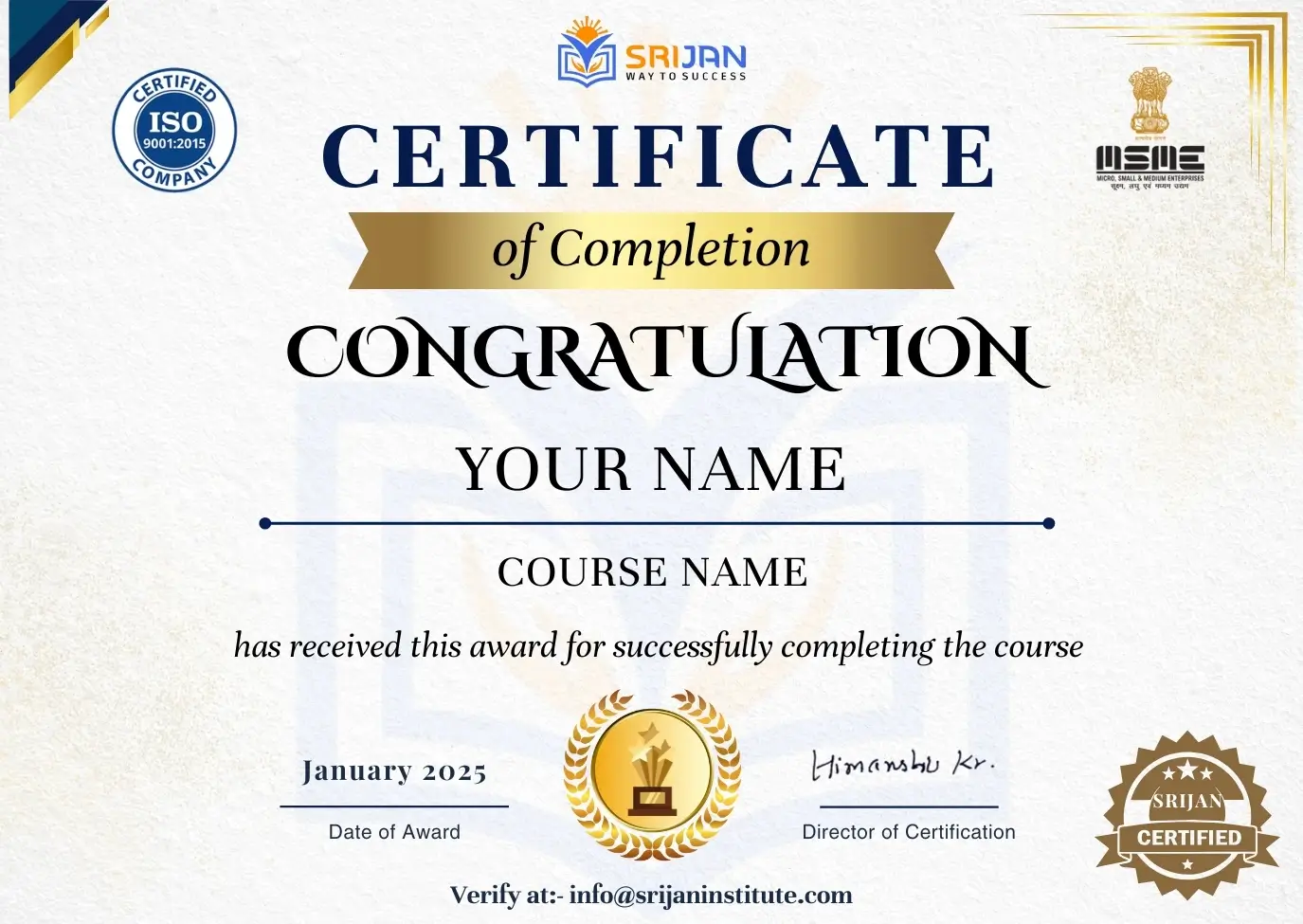
Our Hiring Partners
Our Popular Instructors
Meet our most talented and popular instructors

Mr. Manoj Pandey
SAP| MM| EWM|Ariba|erSAP Global Certified|SAP Consultant

Mr. Amrit Raj
Full Stack SAP Developer CUM ABAP On HANA Trainer | SAP BTP Developer | Full Stack Developer | ERP & Data Science| SAP Global Certified

Mr. Sudheer Sharma
SAP| FICO|Trainer|SAP Consultant

Priyanshu Panday
SAP Basis and Security Consultant

Buddhi Vishwas
SAP HCM and SAP Successfactor Consultant | Payroll | RCM | Employee Central
Choose Us
Why Choose Our Complete SAP ABAP on HANA Course
-
01
Comprehensive Curriculum: Our SAP ABAP on HANA course includes coding, performance tuning, and advanced HANA features. The content is based on the certification criteria given by SAP and is relevant to the modern SAP developer.
-
02
Practical Training: Through Srijan Institute’s SAP ABAP on HANA training, you will also be coding on real-time projects. This practical approach will guarantee that you master both ABAP and HANA integration.
-
03
Expert Instruction: An expert SAP consultant takes you through real-world examples of coding techniques. Their mentorship prepares you for certification and career success.
Choose Your Complete SAP ABAP on HANA Course Learning Plan
Pick the Complete SAP ABAP on HANA Course batch that best fits your schedule—ongoing, upcoming, and recorded options.
On-Going Batch
- First Batch Start Date: 11th November 2025
- Second Batch Start Date: 25th November 2025
($946)
Upcoming Batch
- First Batch Start Date: 9th December 2025
- Second Batch Start Date: 23rd December 2025
($946)
Learn at your own Pace
Self Paced Videos
Learn anytime, anywhere with our curated recorded courses
Complete SAP ABAP on HANA Course FAQs
The training is 80+ live hours long and can be done at your own convenience
It would be helpful but not necessary. Of course, all the basics will be covered.
You can work as an SAP ABAP Consultant, Developer, or Technical Analyst
Yes, the course is designed for beginners and experienced professionals
Yes, after completing the course, you will be issued with an industry-recognized certification.
Level Up Your Skills with Our Complete SAP ABAP on HANA Course Today!
Unlock Your Career Potential with Our Complete SAP ABAP on HANA Course and Start Learning Today and Gain the Skills Employers Demand!


